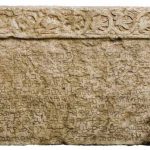Shortly after the creation of the Christian culture based on the Glagolitic script and the Old Church Slavic language was finished by the end of the 9th century in Central Europe, as a result of the work of Saints Cyril and Methodius, this cultural phenomenon spreads to the neighboring countries: southward towards Croatia and eastward towards Bulgaria and Macedonia. The legacy of Saints Cyril and Methodius, who had been building Christian culture in Moravia and Pannonia based on liturgy in the Old Church Slavic language and prayers written in the Glagolitic alphabet since 863, arrived in Croatia by an unknow path. Thus, researchers prefer saying that Glagolitic and its related tradition penetrated this region quietly and unnoticed.
In addition to this historiographical mystery, the discovered monuments, inscribed in stone, or written on parchment or paper, present a testament to the inseparable connection between the Croatian cultural circle and the legacy of Saints Cyril and Methodius. And the monuments speak as witnesses of the time in which the Glagolitic letters were getting through as a companion to the Latin script. In epigraphy, from The Plomin Inscription (11th century), The Valun Tablet (11th century), The Krk Inscription (11th century), The Baška Tablet (12th century), and in liturgical use, from The Vienna Folia to Vatican missal Illirico 4.
It is only known that not even half a century after the death of St. Methodius in 925, in the letter of Pope John X and in the conclusions of the first Church Council of Split, the use of the Glagolitic alphabet in liturgy and other church contexts was first mentioned as an established tradition in the region of the eastern Adriatic coast. And it could have reached the Dalmatian and Croatian regions either from Byzantium through the Adriatic, or by the land that from ancient times connected Byzantium with Central Europe.
Linguistic links point to two different directions where the Glagolitic tradition in Croatia could have originated from. The northern connection with the Pannonian-Moravian area through inculturation activity of Saints Cyril and Methodius seen in preserved Moravianisms in the language, along with the southern connection with the Macedonian and Bulgarian territories, where the legacy of Saints Cyril and Methodius continued through the work of a part of Methodius’ disciples who after the death of their teacher found refuge in the countries of the European Southeast. Along with linguistic links, epigraphic monuments point to the same two paths by which the legacy of Saints Cyril and Methodius reached Croatia. As such, the Glagolitic tradition, i.e. the legacy of Saints Cyril and Methodius, in Croatia becomes a point of convergence between the cultures of the European East and West. The source of Glagolitic literacy was initially in the area of Kvarner, Istria and Littoral, where the earliest epigraphic and liturgical monuments were preserved, but it spread southward, all the way to the Dubrovnik hinterland and in the continental regions to the borders of the Zagreb diocese.
The Glagolitic script was used in the Croatian regions in all areas of social life, mostly in liturgical literature. Thus created, the Croatian Glagolitic liturgical literature as a distinctiveness of the Roman Church culture was in use until the end of the 19th century, i.e. until the last edition of the Roman Missal in Glagolitic by Antun Dragutin Parčić. It was also preserved in notarial records, codes, miscellanies with literary texts translated from Latin or Italian, in margin notes including valuable historical data, as a part of the Croatian literacy and culture.
The Croatian Glagolitic tradition thus took over the original inculturation idea inherent to the legacy of Saints Cyril and Methodius – to create a culture based on a unique alphabet and a language, which, apart from being understandable to the ordinary Slavic folk, will also be the central element of Christian identity.
Kristijan Kuhar, PhD
Old Church Slavic Institute





